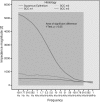Diagnosing early Barrett's neoplasia and oesophageal squamous cell neoplasia by bioimpedance spectroscopy in human tissue
- PMID: 24917967
- PMCID: PMC4040794
- DOI: 10.1177/2050640613495198
Diagnosing early Barrett's neoplasia and oesophageal squamous cell neoplasia by bioimpedance spectroscopy in human tissue
Abstract
Background: Detection of early oesophageal cancer in surrounding normal tissue can be challenging, but detection is essential to determine the subsequent treatment. Dysplastic tissue can be detected by using electrical impedance spectroscopy (EIS).
Objective: The aim of the present study was to evaluate the feasibility and value of EIS in the diagnosis of oesophageal neoplasia.
Methods: This prospective ex-vivo study included 23 patients with early oesophageal cancer (17 with Barrett's cancer and six with early squamous cell cancer). Immediately after endoscopic resection, the electrical properties of the resected specimens were investigated using a pencil probe (5 mm in diameter, frequency range from 100 Hz to 1 MHz). Punch biopsies were taken from the measured site in order to compare the results of EIS with histology.
Results: EIS was able to detect dysplastic oesophageal mucosa with a high rate of accuracy (82% in Barrett's oesophagus and 100% in squamous oesophagus) A total of 54 different sites in 26 tumours were evaluated.
Conclusions: EIS was able to differentiate reliably between non-neoplastic and neoplastic oesophageal mucosa. Using EIS, it might be possible to use it for targeted biopsies and to avoid unnecessary biopsies during cancer surveillance in future.
Keywords: Barrett’s carcinoma; Early oesophageal cancer; squamous cell cancer; surveillance; target biopsy.
Figures



Similar articles
-
Fluorescence spectroscopy incorporated in an Optical Biopsy System for the detection of early neoplasia in Barrett's esophagus.Dis Esophagus. 2015 May-Jun;28(4):345-51. doi: 10.1111/dote.12193. Epub 2014 Mar 6. Dis Esophagus. 2015. PMID: 24602242
-
Comparison of methylene blue-directed biopsies and four-quadrant biopsies in the detection of high-grade intraepithelial neoplasia and early cancer in Barrett's oesophagus.Dig Liver Dis. 2006 Oct;38(10):724-9. doi: 10.1016/j.dld.2006.05.025. Epub 2006 Sep 5. Dig Liver Dis. 2006. PMID: 16911879
-
Aberrant expression of minichromosome maintenance proteins 2 and 5, and Ki-67 in dysplastic squamous oesophageal epithelium and Barrett's mucosa.Gut. 2002 Mar;50(3):373-7. doi: 10.1136/gut.50.3.373. Gut. 2002. PMID: 11839717 Free PMC article.
-
Endoscopic risk factors for neoplastic progression in patients with Barrett's oesophagus.United European Gastroenterol J. 2016 Oct;4(5):657-662. doi: 10.1177/2050640616635509. Epub 2016 Mar 2. United European Gastroenterol J. 2016. PMID: 27733907 Free PMC article. Review.
-
Barrett's oesophagus: new diagnostic and therapeutic techniques.Scand J Gastroenterol Suppl. 2002;(236):9-14. doi: 10.1080/003655202320621382. Scand J Gastroenterol Suppl. 2002. PMID: 12408497 Review.
Cited by
-
Design, Construction and Validation of an Electrical Impedance Probe with Contact Force and Temperature Sensors Suitable for in-vivo Measurements.Sci Rep. 2018 Oct 4;8(1):14818. doi: 10.1038/s41598-018-33221-4. Sci Rep. 2018. PMID: 30287842 Free PMC article.
-
The clinical application of electrical impedance technology in the detection of malignant neoplasms: a systematic review.J Transl Med. 2020 Jun 8;18(1):227. doi: 10.1186/s12967-020-02395-9. J Transl Med. 2020. PMID: 32513179 Free PMC article.
-
Virtual Biopsy by Electrical Impedance Spectroscopy in Barrett's Carcinoma.J Gastrointest Cancer. 2022 Dec;53(4):948-957. doi: 10.1007/s12029-021-00703-0. Epub 2021 Sep 24. J Gastrointest Cancer. 2022. PMID: 34559362 Free PMC article. Clinical Trial.
References
-
- Pech O, Behrens A, May A, et al. Long-term results and risk factor analysis for recurrence after curative endoscopic therapy in 349 patients with high-grade intraepithelial neoplasia and mucosal adenocarcinoma in Barrett's oesophagus. Gut 2008; 57: 1200–1206 - PubMed
-
- Suselbeck T, Thielecke H, Weinschenk I, et al. In vivo intravascular electric impedance spectroscopy using a new catheter with integrated microelectrodes. Basic Res Cardiol 2005; 100: 28–34 - PubMed
-
- Brown BH, Tidy JA, Boston K, et al. Relation between tissue structure and imposed electrical current flow in cervical neoplasia. Lancet 2000; 355: 892–895 - PubMed
-
- Schwan HP. Electrical properties of tissue and cell suspensions. Adv Biol Med Phys 1957; 5: 147–209 - PubMed
-
- Farre R, Blondeau K, Clement D, et al. Evaluation of oesophageal mucosa integrity by the intraluminal impedance technique. Gut 2011; 60: 885–892 - PubMed
LinkOut - more resources
Full Text Sources
Other Literature Sources

